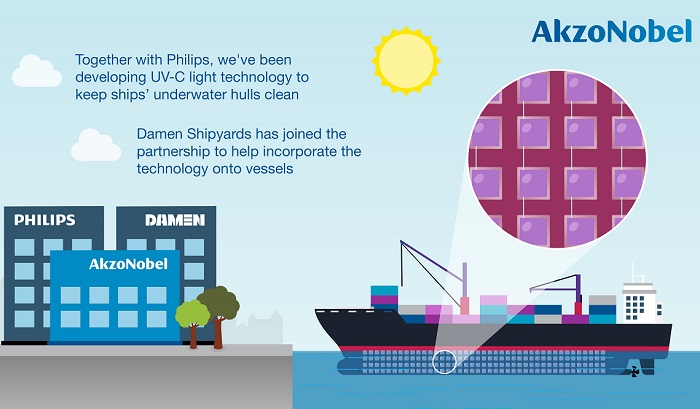Damen Shipyards has teamed up with AkzoNobel and Philips to help further develop a state-of-the-art fouling control solution that uses UV-C light technology to keep underwater vessel hulls clean.
AkzoNobel
and Philips have announced a new partnership with Damen Shipyards to develop a state-of-the-art antifouling solution. This technology integrates UV-C light emitting diodes (LEDs) into a coating scheme that emits enough light to provide total prevention of bio-fouling accumulation on the protected area.
“We were both delighted and excited to welcome Damen Shipyards to the consortium. As a leading international shipbuilder, they will bring essential knowledge and experience and significantly increase our chances of success”, says Ralph Slikkerveer, Research and Development Director for Marine, Protective and Yacht Coatings at AkzoNobel.
Although successful small-scale trials have already taken place, bringing Damen Shipyards on board will add vital expertise in areas such as vessel integration – perfectly complementing AkzoNobel’s surface protection and adhesion know-how and Philips’ unrivalled capabilities in UV-C LED applications and electronics. It was 2014 when Philips started experimenting with UV-C LED technology, known for its use in water treatment and sterilization applications, but it had never been used in the open ocean before. Since joining forces with AkzoNobel, promising progress has been made to the point where tests on merchant vessels have taken place.

The three companies will now collaborate to build on the advances AkzoNobel and Philips have made since the first creation of the RunWell consortium in 2017. The goal is to create a completely biocide-free fouling control solution that delivers breakthrough performance, bringing economic and environmental benefits.
Jasper Schuringa, Head of Corporate Venturing at Damen Shipyards, adds: “This is a very exciting project and an excellent fit with our own strategy to become the world’s most sustainable shipbuilder. There’s still some way to go, but the solution being developed clearly has the potential to reshape how the industry has traditionally thought about anti-fouling systems.”
In addition to continuing to improve the technology, a key next step for the consortium is vessel integration, and all three partners will now be working to create a commercially viable solution in the near future. “It is a challenging project, but it’s also a fantastic example of the benefits of collaborative innovation,” continues Slikkerveer. “By working together as a strong partnership of three complementary Dutch companies, we are confident we can combine our capabilities to deliver a sustainable solution that could completely revolutionize the fouling control industry.”